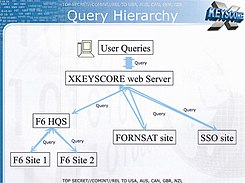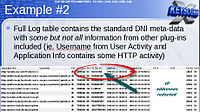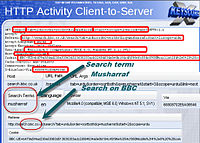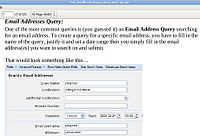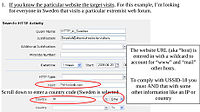-
(시사) 미국 국가안보국이 만든 강력한 인터넷 도감청 프로그램 '엑스키스코어(XKeyscore)' (영문자료)사람되기/시사 2015. 11. 16. 00:14
출처: https://en.wikipedia.org/wiki/XKeyscore
미국 국가안보국이 만든 강력한 전세계의 인터넷 도감청 프로그램 '엑스키스코어'에 대한 한국자료가 없어 WIKIPEDIA 위키페디아의 영문자료를 아래와 같이 소개한다. 미국이 어떤 나라인가 그 실체(?)를 보여주는 자료다.
미국 국가안보국이 만든 강력한 인터넷 도감청 프로그램 '엑스키스코어(XKeyscore)
XKeyscore
From Wikipedia, the free encyclopedia코어 
National Security Agencysurveillance
XKeyscore or XKEYSCORE (abbreviated as XKS) is a formerly secret computer system first used by the United States National Security Agency for searching and analyzing global Internet data, which it collects on a daily basis. The program has been shared with other spy agencies including the Australian Signals Directorate, Communications Security Establishment Canada, New Zealand's Government Communications Security Bureau and the German Bundesnachrichtendienst.[1]
The program's purpose was publicly revealed in July 2013 by Edward Snowden in The Sydney Morning Herald and O Globonewspapers. The codename was already public knowledge because it is mentioned in earlier articles, and like many other codenames can also be seen in job postings, and in the online resumes of employees.[2][3]
On July 3, 2014 excerpts of XKeyscore's source code were first published by German public broadcaster Norddeutscher Rundfunk, a subsidiary of ARD.[4] A team of experts analyzed the source code.[5] Recent articles mention that XKEYSCORE uses user metricsto flag certain data, such as race, sex, ethnicity, and geolocation.[citation needed]
Scope and functioning[edit]
XKeyscore is a complicated system and various authors have different interpretations of its actual capabilities. Edward Snowden andGlenn Greenwald explained XKeyscore as being a system which enables almost unlimited surveillance of anyone anywhere in the world, while the NSA has said that usage of the system is limited and restricted.
According to The Washington Post and national security reporter Marc Ambinder, XKeyscore is an NSA data-retrieval system which consists of a series of user interfaces, backend databases, servers and software that selects certain types of data and metadata that the NSA has already collected using other methods.[6][7]
According to Snowden and Greenwald[edit]
On January 26, 2014, the German broadcaster Norddeutscher Rundfunk asked Edward Snowden in its TV interview: "What could you do if you would [sic] use XKeyscore?" and he answered:[1]
According to The Guardian's Glenn Greenwald, low-level NSA analysts can, via systems like XKeyscore, "listen to whatever emails they want, whatever telephone calls, browsing histories, Microsoft Word documents. And it's all done with no need to go to a court, with no need to even get supervisor approval on the part of the analyst."[8]
He added that the NSA's databank of collected communications allows its analysts to listen "to the calls or read the emails of everything that the NSA has stored, or look at the browsing histories or Google search terms that you've entered, and it also alerts them to any further activity that people connected to that email address or that IP address do in the future".[8]
According to the NSA[edit]
In an official statement from July 30, 2013, the NSA said "XKeyscore is used as a part of NSA's lawful foreign signals intelligence collection system. [...]" to legally obtain information about "legitimate foreign intelligence targets in response to requirements that our leaders need for information necessary to protect our nation and its interests. [...] to collect the information, that enables us to perform our missions successfully – to defend the nation and to protect U.S. and allied troops abroad."[9] In terms of access, an NSA press statement reads that there is no "unchecked analyst access to NSA collection data. Access to XKeyscore, as well as all of NSA's analytic tools, is limited to only those personnel who require access for their assigned tasks." and that there are "[...]stringent oversight and compliance mechanisms built in at several levels. one feature is the system's ability to limit what an analyst can do with a tool, based on the source of the collection and each analyst's defined responsibilities."[10]
Workings[edit]
According to an NSA slide presentation about XKeyscore from 2013 it is a "DNI Exploitation System/Analytic Framework". DNI stands for Digital Network Intelligence, which means intelligence derived from internet traffic.[11]
Edward Snowden said about XKeyscore: "It’s a front end search engine" in an interview with the German Norddeutscher Rundfunk.[12]
XKeyscore is considered a "passive" program, in that it listens, but does not transmit anything on the networks that it targets.[5] But it can trigger other systems, which perform "active" attacks through Tailored Access Operations which are "tipping", for example the Quantum family of programs, including Quantuminsert, Quantumhand, Quantumtheory, Quantumbot and Quantumcopper andTurbulence. These run at so-called "defensive sites" including the Ramstein Air Force base in Germany, Yokota Air Base in Japan, and numerous military and non-military locations within the US. Trafficthief, a core program of Turbulence, can alert NSA analysts when their targets communicate, and trigger other software programs, so select data is "promoted" from the local XKeyscore data store to the NSA's "corporate repositories" for long term storage.[5]
Data sources[edit]
XKeyscore consists of over 700 servers at approximately 150 sites where the NSA collects data, like "US and allied military and other facilities as well as US embassies and consulates" in many countries around the world.[13][14][15] Among the facilities involved in the program are four bases in Australia and one in New Zealand.[14]
According to an NSA presentation from 2008, these XKeyscore servers are fed with data from the following collection systems:[16]
- F6 (Special Collection Service) – joint operation of the CIA and NSA that carries out clandestine operations including espionage on foreign diplomats and leaders
- FORNSAT – which stands for "foreign satellite collection", and refers to intercepts from satellites
- SSO (Special Source Operations) – a division of the NSA that cooperates with telecommunication providers
In a single, undated slide published by Swedish media in December 2013, the following additional data sources for XKeyscore are mentioned:[17]
- Overhead – intelligence derived from American spy planes, drones and satellites
- Tailored Access Operations – a division of the NSA that deals with hacking and cyberwarfare
- FISA – all types of surveillance approved by the Foreign Intelligence Surveillance Court
- Third party – foreign partners of the NSA such as the (signals) intelligence agencies of Belgium, Denmark, France, Germany, Italy, Japan, the Netherlands, Norway, Sweden, etc.
From these sources, XKeyscore stores "full-take data", which are indexed by plug-ins that extract certain types of metadata (like phone numbers, e-mail addresses, log-ins, and user activity) and index them in metadata tables, which can be queried by analysts. XKeyscore has been integrated with MARINA, which is NSA's database for internet metadata.[11]
However, the system continuously gets so much Internet data that it can be stored only for short periods of time. Content data remain on the system for only three to five days, while metadata is stored for up to thirty days.[18] A detailed commentary on an NSA presentation published in The Guardian in July 2013 cites a document published in 2008 declaring that "At some sites, the amount of data we receive per day (20+ terabytes) can only be stored for as little as 24 hours."[19]
Types of XKeyscore[edit]
According to a document from an internal GCHQ website which was disclosed by the German magazine Der Spiegel in June 2014, there are three different types of the Xkeyscore system:[20]
- Traditional: The initial version of XKeyscore is fed with data from low-rate data signals, after being processed by the WEALTHYCLUSTER system. This traditional version is not only used by NSA but also at many intercept sites of GCHQ.
- Stage 2: This version of XKeyscore is used for higher data rates. The data are first processed by the TURMOIL system, which sends 5% of the internet data packets to XKeyscore. GCHQ only uses this version for its collection under the MUSCULAR program.
- Deep Dive: This latest version can process internet traffic at data rates of 10 gigabit per second. Data that could be useful for intelligence purposes are then selected and forwarded by using the "GENESIS selection language". GCHQ also operates a number of Deep Dive versions of XKeyscore at three locations under the codenameTEMPORA.[21]
Capabilities[edit]
For analysts, XKeyscore provides a "series of viewers for common data types", which allows them to query terabytes of raw data gathered at the aforementioned collection sites. This enables them to find targets that cannot be found by searching only the metadata, and also to do this against data sets that otherwise would have been dropped by the front-end data processing systems. According to a slide from an XKeyscore presentation, NSA collection sites select and forward less than 5% of the internet traffic to the PINWALE database for internet content.[18]
Because XKeyscore holds raw and unselected communications traffic, analysts can not only perform queries using "strong selectors" like e-mail addresses, but also using "soft selectors", like keywords, against the body texts of e-mail and chat messages and digital documents and spreadsheets in English, Arabic and Chinese.[11]
This is useful because "a large amount of time spent on the web is performing actions that are anonymous" and therefore those activities can't be found by just looking for e-mail addresses of a target. When content has been found, the analyst might be able to find new intelligence or a strong selector, which can then be used for starting a traditional search.[11]
Besides using soft selectors, analysts can also use the following other XKeyscore capabilities:[11][22]
- Look for the usage of Google Maps and terms entered into a search engine by known targets looking for suspicious things or places.
- Look for "anomalies" without any specific person attached, like detecting the nationality of foreigners by analyzing the language used within intercepted emails. An example would be a German speaker in Pakistan. The Brazilian paper O Globo claims that this has been applied to Latin America and specifically to Colombia, Ecuador, Mexico and Venezuela.[13][23]
- Detect people who use encryption by doing searches like "all PGP usage in Iran". The caveat given is that very broad queries can result in too much data to transmit back to the analyst.
- Showing the usage of virtual private networks (VPNs) and machines that can potentially be hacked via TAO.
- Track the source and authorship of a document that has passed through many hands.
- On July 3, 2014 ARD revealed that XKeyscore is used to closely monitor users of the Tor anonymity network,[5] people who search for privacy-enhancing software on the web,[5] and readers of Linux Journal.[24]
The Guardian opined in 2013, that most of these things cannot be detected by other NSA tools, because they operate with strong selectors (like e-mail and IP addresses and phone numbers) and the raw data volumes are too high to be forwarded to other NSA databases.[11]
In 2008, NSA planned to add a number of new capabilities in the future, like VoIP, more networking protocols[clarify], Exif tags, which often include geolocation (GPS) data.[11]
Contribution to US security[edit]
The NSA slides published in The Guardian during 2013 claimed that XKeyscore had played a role in capturing 300 terrorists by 2008,[11] which could not be substantiated as the redacted documents do not cite instances of terrorist interventions.
A 2011 report from the NSA unit in the Dagger Complex (close to Griesheim in Germany) said that XKeyscore made it easier and more efficient to target surveillance. Previously, analysis often accessed data NSA was not interested in. XKeyscore allowed them to focus on the intended topics, while ignoring unrelated data. XKeyscore also proved to be outstanding for tracking active groups associated with the Anonymous movement in Germany, because it allows for searching on patterns, rather than particular individuals. An analyst is able to determine when targets research new topics, or develop new behaviors.[25]
To create additional motivation, the NSA incorporated various features from computer games into the program. For instance, analysts who were especially good at using XKeyscore could acquire "skilz" points and "unlock achievements." The training units in Griesheim were apparently successful and analysts there had achieved the "highest average of skilz points" compared with all other NSA departments participating in the training program.[25]
Usage by foreign partners of the NSA[edit]
Germany[edit]
According to documents Der Spiegel acquired from Snowden, the German intelligence agencies BND (foreign intelligence) and BfV(domestic intelligence) were also allowed to use the XKeyscore system. In those documents the BND agency was described as the NSA's most prolific partner in information gathering.[26] This led to political confrontations, after which the directors of the German intelligence agencies briefed members of the German parliamentary intelligence oversight committee on July 25, 2013. They declared that XKeyscore has been used by the BND since 2007 and that the BfV uses a test version since 2012. The directors also explained that this program is not for collecting data, but only for analyzing them.[27]
Sweden[edit]
As part of the UKUSA Agreement, a secret treaty was signed in 1954 by Sweden with the United States, the United Kingdom, Canada, Australia and New Zealand (called theFive Eyes) for the purpose of intelligence collaboration and data sharing.[28] According to documents leaked by Snowden, the National Defence Radio Establishment (FRA) has been granted access to XKeyscore.[29]
Gallery[edit]
See also[edit]
- List of government surveillance projects
- PRISM
- File:XKeyscore presentation from 2008.pdf, A redacted presentation about X-Keyscore via The Guardian (UK) via Edward Snowden via US National Security Agency
References[edit]
- ^ a b "Snowden Interview Transcript". NDR. n.d. Retrieved 27 January 2014.[dead link]
- ^ Greenwald, Glenn; Ackerman, Spencer (June 27, 2013). "How the NSA Is Still Harvesting Your online Data – Files Show Vast Scale of Current NSA Metadata Programs, with one Stream Alone Celebrating 'one Trillion Records Processed'". The Guardian. Retrieved August 5, 2013.
- ^ Layne, Ken (June 18, 2013). "Job Networking Site LinkedIn Filled With Secret NSA Program Names". Retrieved August 6, 2013.
- ^ "xkeyscorerules100". Panorama (ARD (broadcaster)). 3 July 2014. Retrieved 4 July2014.
- ^ a b c d e Jacob Appelbaum, A. Gibson, J. Goetz, V. Kabisch, L. Kampf, L. Ryge (3 July 2014). "NSA targets the privacy-conscious". Panorama (Norddeutscher Rundfunk). Retrieved 4 July 2014.
- ^ Nakashima, Ellen (July 31, 2013). "Newly Declassified Documents on Phone Records Program Released". The Washington Post. Retrieved August 6, 2013.
- ^ Fisher, Max (August 1, 2013). "Is XKeyscore Still Active? Defense Contractor Posted a Job Listing for it 2 weeks Ago". WorldViews (blog of The Washington Post). RetrievedAugust 6, 2013.
- ^ a b Rea, Kari (July 28, 2013). "Glenn Greenwald: Low-Level NSA Analysts Have 'Powerful and Invasive' Search Tool". ABC News. Retrieved August 4, 2013.
- ^ Wills, Amanda (August 1, 2013). "New Snowden Leak: NSA Program Taps All You Do online". Mashable (via CNN). Retrieved August 4, 2013.
- ^ NSA Press Statement on 30 July 2013
- ^ a b c d e f g h Staff (July 31, 2013). "XKeyscore Presentation from 2008 – Read in Full". The Guardian. Retrieved August 6, 2013.
- ^ "Snowden Interview Transcript". Norddeutscher Rundfunk. n.d. Retrieved 27 January2014.[dead link]
- ^ a b Staff (undated; circa July 2013). "No alvo dos EUA – O big-brother na América Latina e no mundo" [The U.S. Targets – Big Brother in Latin America and in the World].O Globo (in Portuguese). Retrieved August 5, 2013. Check date values in:
|date=(help) - ^ a b Dorling, Philip (July 8, 2013). "Snowden Reveals Australia's Links to US Spy Web".The Sydney Morning Herald. Retrieved August 2, 2013.
- ^ Greenwald, Glenn; Casado, Roberto Kaz e José (July 6, 2013). "EUA expandem o aparato de vigilância continuamente – Software de vigilância usa mais de 700 servidores espalhados pelo mundo". O Globo (in Portuguese). Retrieved August 2, 2013.
- ^ Ambinder, Marc (July 31, 2013). "What's XKEYSCORE?". The Compass (blog of The Week). Retrieved August 4, 2013.
- ^ Gunnar Rensfeldt. "Read the Snowden Documents From the NSA". Sveriges Television. Retrieved 21 December 2013.
- ^ a b See also: 3 slides about the XKeyscore program
- ^ Greenwald, Glenn (July 31, 2013)."XKeyscore: NSA tool collects 'nearly everything a user does on the internet' – XKeyscore Gives 'Widest-Reaching' Collection of online Data – NSA Analysts Require No Prior Authorization for Searches – Sweeps Up Emails, Social Media Activity and Browsing History". The Guardian. Retrieved August 1, 2013.
- ^ XKeyscoreTabs XKS Development, published by Der Spiegel on June 18, 2014
- ^ Der Spiegel: GCHQ report on the technical abilities of the powerful spying program TEMPORA, which allows for a "full take"
- ^ Gallagher, Sean (August 1, 2013). "NSA's Internet Taps Can Find Systems to Hack, Track VPNs and Word Docs – X-Keyscore Gives NSA the Ability to Find and Exploit Vulnerable Systems". Ars Technica. Retrieved August 4, 2013.
- ^ Greenwald, Glenn; Casado, Roberto Kaz e José (July 13, 2013). "Espionagem dos EUA se espalhou pela América Latina – Depois do Brasil, Colômbia foi o país mais vigiado – Venezuela também entrou na mira de programas americanos" [U.S. Spying Spread Through Latin America – After Brazil, Colombia Was the Country's Most Watched – Venezuela Also Came in the Crosshairs of U.S. Programs]. O Globo (in Portuguese). Retrieved August 5, 2013.
- ^ Kyle Rankin (3 July 2014). "NSA: Linux Journal is an "extremist forum" and its readers get flagged for extra surveillance".
- ^ a b Laura Poitras, Marcel Rosenbach and Holger Stark, Ally and Target: US Intelligence Watches Germany Closely, August 12, 2013.
- ^ Staff (July 20, 2013). "'Prolific Partner': German Intelligence Used NSA Spy Program".Der Spiegel. Retrieved August 5, 2013.
- ^ Top Level Telecommunications, New slides about NSA collection programs, July 16, 2013
- ^ "Cold War treaty confirms Sweden was not neutral". The Local. Retrieved12 December 2013.
- ^ Gunnar Rensfeldt. "Read the Snowden Documents From the NSA". Sveriges Television. Retrieved 12 December 2013.
External links[edit]

Wikimedia Commons has media related to XKeyscore. - A full NSA presentation about XKeyscore from 2008
- Building a panopticon: The evolution of the NSA’s XKeyscore
- Marquis-Boire, Morgan; Greenwald, Glenn; Lee, Micah (1 July 2015). "XKEYSCORE: NSA’s Google for the World’s Private Communications". The Intercept. Retrieved 5 July 2015.
- Lee, Micah; Greenwald, Glenn; Marquis-Boire, Morgan (2 July 2015). "Behind the Curtain; A Look at the Inner Workings of NSA’s XKEYSCORE". The Intercept. Retrieved5 July 2015.
[show] Categories:- 2013 scandals
- Counter-terrorism policy of the United States
- Espionage
- Human rights
- Mass surveillance
- Obama administration controversies
- Privacy in the United States
- Privacy of telecommunications
- American secret government programs
- Surveillance scandals
- United States national security policy
- War on Terror
- Government Communications Headquarters operations and programs
- National Security Agency operations and programs
- Intelligence agency programmes revealed by Edward Snowden
'사람되기 > 시사' 카테고리의 다른 글
(시사) 에드워드 스노우덴(Edward Snowden)이 밝힌 미국의 감시 프로그램 (0) 2015.11.16 (시사) 한겨레신문 사설: 온 나라가 감시당하는데도 침묵하는 한국정부 (0) 2015.11.16 (시사) 영미 협정(UKUSA Agreement) (영문자료) (0) 2015.11.15 (시사) 美 국가안보국(NSA) 주도 영어권 5개국 정보연합체 Five Eyes (영문자료) (0) 2015.11.15 (시사/동영상) 뉴스타파 - 26조 전투기 사업...또 ‘글로벌 호갱님’ 인증(2015.11.5) (0) 2015.11.12


